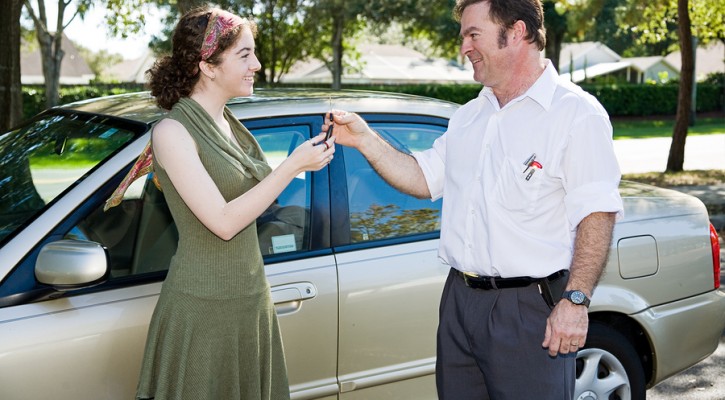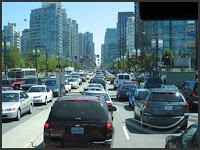Tag Archive: driver safety

GPS Tracking Technology that Promotes Safe Teen Driving
July 6, 2010
GPS technology has existed for at least 30 years and over the last decade, we’ve seen a boom in consumer devices that utilize it. With faster satellite relays and increased accuracy it’s no wonder that there are more practical applications for everyday GPS use; for instance, teen driving safety
Most people think of in–vehicle GPS systems as simply a tool for helping a driver to get directions from point A to B however there are several GPS systems that are being marketed to parents for safer teen driving. All of these systems help parents or guardians keep track of the whereabouts of their teen driver via GPS location and only differ in the features they’ve included with each one.
Here’s a quick rundown on some of them:
Spark Nano – http://www.brickhousesecurity.com/product/spark+nano+gps+tracking+device.do, $99 plus subscription fees
The Spark Nano is marketed as the smallest, most highly-sensitive GPS tracking device for tracking teen drivers. This battery operated, web enabled device allow parents or guardians to keep track of their teen in real time. It also keeps track of speed, so parents know how fast their teen driver was going. The additional feature in this one is a panic button, which when pressed sends out alerts to parents of their location and that they are in need of assistance.
mobileteen GPS – http://www.mobileteengps.com/, $299 plus monitoring plan
The mobileteen GPS system, when installed in a vehicle, allows a parent/guardian to keep track of how fast the car was moving, and how long the car has been in one location. Parents/guardians can login to their site to monitor real-time activities. It also allows parents/guardians to set a “ForceField” to alert them via text messaging or email when the car moves, useful when they are out of town, or when the teen is forbidden from driving. It also allows them to set approved/unapproved driving locations and to be alerted when a violation is committed. There is also a Repair/Response feature that helps locate teen drivers when they are having problems with the vehicle.
Safe Teen Driving Club’s Active GPS System – https://www.safeteendrivingclub.org/prodpurchase_vt.php.
This system also acts as an anti-theft device for the vehicle and could help lower insurance rates. The Active GPS System only activates when the ignition is on. It tracks speed and location, and sends out automatic reports (set by the user). The parent or guardian may also check a web-based site to view the real-time coordinates of their teen driver on a map. This system has to be professionally-installed, and that may add to the total cost of the system.
Marcus Teen Tracking System –
The Marcus Teen Tracking System provides real-time location information on your teen drivers and alerts parents or guardians if they go beyond a certain speed. It also allows the creation of unapproved driving zones and provides driving directions.
Additional Driver Safety Information on In-Vehicle Technology:
The Drawbacks Of In-Vehicle Technology

Driver Education Information That Could Save Your Life
May 21, 2010
Driver education can save thousands of lives. Don’t believe me? Imagine a car and a gun side-by-side. Tell me, which do you think has taken more teen lives? If you feel like the answer should be the gun, think about this for awhile: which one of the two do you see more often day-to-day? While most of the country pays close attention to the subject of gun control or the views of the National Rifle Association, very little focus is given to the number one cause of death for teens- Car Crashes.
The need for driver education is very important because so many of us take the right and the responsibility of driving every day for granted. We travel the roadways and go about our daily routines without the safety reminders we all need. And if you are a new driver— you need the reminders more frequently. We’re going to discuss the basics — the lessons you should be absorbing. This is by no means a substitute for actual driver education, just a summary of the information you may need a refresher on and could save your life.
Buckle Up – Before even starting the car or stepping on the accelerator, always fasten your seat belts. Each year, over 400,000 teen drivers between the ages 16 and 20 get injured in car crashes. Wearing your seat belt will help save your life. It will keep you from being thrown out of the vehicle, lessen the force of impact when hitting the dashboard or other interior spaces in the vehicle and reduce the collision forces on your internal organs. Coupled with air bags, what would be a fatal crash can be reduced to one with only minor injuries. This is also true for your passengers. Make sure they fasten their seat belts. In the event of a crash, if they are not properly belted they can literally become a flying object within the car causing serious injury themselves and other occupants.
Overcrowding – When driving a car, you are not only responsible for your safety, but also for the safety of all your passengers. Being a teen driver already increases your crash risk, but having other teens in the vehicle actually doubles that. Teens make up about 12% of all fatal car crashes in the United States. Overcrowding not only affects the way you drive overall, but causes distractions while driving. In some states, you can be ticketed and fined for driving with minors in the car.
Overloading – A fact you learn in driver education: for every 100 pounds in the car’s trunk, we lower the car’s fuel economy by 2%. This may seem like a low number, but it adds up in the long run. Not only that, but it shifts the center of gravity of your vehicle which in turn affects engine performance, braking distance, and how the vehicle reacts in an emergency. If you’re planning on carrying a lot of stuff — don’t stuff it in the trunk, call a moving van instead.
Emergency Kit – Driver education teaches you all aspects of driving: from trip preparation, operating a vehicle, laws and safety guidelines, defensive driving techniques and handling vehicle emergencies. Always make sure that, when faced with a vehicular emergency, breathe — stay calm. Panicking does not fix your car or improve the situation. If you plan ahead with the proper knowledge, a vehicle emergency tool kit including a spare tire, you’re going to be okay. If you can’t fix the vehicle, remember to have a fully-charged phone, with all your emergency numbers before leaving.
Car Maintenance – Do you know how to check your oil? Is there enough fuel in the tank? Can you check if your tires are worn? Can you check the tire pressure? Are your mirrors adjusted correctly? These are small things you should know how to do after attending driver education — and you should turn this into a routine!
Defensive Driving Techniques – Do you know where your blind spots are and check them each time? Do you keep a space cushion around your vehicle? Is there always a minimum of a two second following distance between your vehicle and the one ahead? Do you look left right left again before entering and intersection? These are some of the many techniques to be a defensive driver and a driver education course covers them.
Driver education is a small step for turning teens into competent drivers on the road. Not only that, but driver proficiency is a skill you will be carrying for life — knowing the small things could save your life in the future! If you have a good attitude towards learning, and you try to learn as much as you can, you are well on your way to becoming a great driver.

Parents are the Key to Teen Driving Safety
April 6, 2010
Imagine your 16-year old, late after his first solo drive — the phone rings and it’s your child, asking you to pick him up. He lets you know that he had an accident. You feel relief that everyone is safe, you bring both the vehicle and your child home. As you begin to understand what happened, you think how could I have prepared my child for this situation.
Having a conversation about how to handle a vehicle emergency is the right start. For many new drivers, more behind the wheel experience in a variety of driving scenarios including adverse weather conditions or driving on the highway can greatly improve their driving skills. In addition making sure that the car is properly maintained should also be a priority.
For many new drivers, parents are the key to teen driving safety.
The first few years are the most dangerous for the new driver. Statistics don’t lie — for nearly a decade, (1995 – 2004) more than 30% of all crashes involved teen drivers. Leading to the creation of the Graduated Driver’s License law, making parents more important in the lives of their teen drivers. These laws allow for a new driver to prove their maturity and trustworthiness.
Depending on what state you live in, your teen driver might need more in-car experience. As mentioned above, various states have a form of the GDL law, requiring up to 50 hours of supervised driving, including 10 hours of night-time driving. To help track and log your teens driving hours you can use a Teen Driving Experience Log Book to track the maneuvers practiced, the weather conditions or even the route.
There is bond that helps children understand a lesson better, if taught by his parents. Please keep this in mind as your child prepares for the responsibility of driving. Remember, parents are the first teachers for most experiences in their teens life.
For additional information on Graduated Drivers License Laws read:
Four Ways Teens Benefit from Following Graduated Drivers License Laws

Are you an Aggressive Driver
January 12, 2010
Well are you? Have you ever found yourself in a situation, where a driver cuts off on the highway, a driver in front is braking erratically, or even simply driving below the speed limit? How did you react to this? Some people would simply put up with it, it probably wouldn’t even affect others, but a few of us get wound up and angry at this person, and sometimes can end up lashing out. Does this sound like you? A recent survey of 526 motorists found that within the previous 12 months almost 90% stated that they had experienced behavior that could be classified as road rage.
Aggressive driving can involve a number of things and situations, including following too close, speeding, weaving through traffic, using your horn excessively, not obeying traffic safety rules, verbally lashing out at over drivers and passengers in your vehicle, even just mentally condemning them for whatever they did to anger you! But have you ever stopped to think about the other driving that you’re condemning?
- 52% of drivers say they have experienced verbal abuse or gestures from another driver.
- 9% said they had been forced to pull over or forced completely off the road, while 3% said another driver had got out of their car and threatened them with violence.
Sometimes people drive the way they do for valid reasons. Have you ever thought a driver could be breaking randomly because of a screaming baby, a loose pet, or even because there is a bee in the car? That maybe a car cut you off because there’s an emergency? Always put yourself in the other driver’s shoes.
Admittedly however, you will come across some bad drivers in your lifetime, but it’s important that you control your anger, and learn how to handle situations effectively so as not to loose your temper, because aggressive driving does not have a positive outcome.
If you are seen and reported driving aggressively, or find yourself in an accident or situation because of your aggressive driving and face all sorts of penalties, such as fines, driving bans, prosecution, community sentence, compensation pay-out to the victim of your rage, and in more severe cases, you could even face jail.
If you suffer from aggressive driving and road rage, stop and think about what you could be facing, and what you could risk losing if you persist. But there are ways you can reduce your aggression and rage, in order to become a safe driver again.
Always get your sleep, don’t stay out all night when you know you have to be up early. We all know we can get irritable and cranky when we don’t have enough sleep. Tiredness is one of the main causes of road rage and aggressive driving, according to the National Sleep Foundation. So make sure you stock up on those Z’s!
Perhaps change the music you listen to. There’s an age old argument that says aggressive music leads to aggressive people, this isn’t strictly true in most cases, but what music you listen to can effect your driving. Aggressive or bass driven music can get you pumped up and ready for action! If you know your music effects you, then change it, you don’t have to drive along to classical if you don’t want, try listening to audio books, or even a comedy station. Listening to comedy can especially lighten our moods, and it can even drown out the traffic noise! Give it a try, it might help.
And do you ever actually leave yourself enough time to get to work? Being late can make us stressed and angry, if you allow yourself enough time to get to work make it through the traffic, if it’s the traffic that’s making your angry, try leaving early to beat it, or even just finding an alternative route. Couple this with some comedy radio or relaxing music, and you’re on the road to calm!
And always remember it’s not about you. Drivers are not out to specifically get you angry, you are not the target, like I said before, perhaps they have a reason? Roll your window down, and take deep breaths to calm yourself if you feel yourself getting angry, it sounds silly, but it does work.
If you think your aggressive driving is really bad, and these techniques are not helping, then there are groups you can join that can take your problem to the root, and give you more extensive techniques in order to help you.
Remember, aggressive driving is not okay, it’s dangerous and you could be risking far more than your money and your freedom. Take steps today to curb your road rage and work your way towards a better driving life today.
Teaching Your Teen To Drive During the Christmas Holiday Season
December 14, 2009
The Christmas season is supposed to bring out the best in us but, for drivers, it seems to bring out the worse. The mad rush to commute from work, get to the mall, and complete our shopping in a reasonable amount of time, makes this season one of the most dangerous driving periods of the year. With the arrival of the Christmas shopping season, parents, whose children are learning to drive on a learner’s permit, may be reluctant to let their teen drive in such a crazy driving environment.
Only you can decide whether or not your teen may be prepared to drive during this season. For a teen who only has a month or so of driving experience, it is probably not a good idea to allow them to drive in heavy Christmas traffic. However, for a teen with a good deal of driving experience, it is probably the best time to allow them to drive while you are in the seat next to them to give them guidance. This season presents a great teaching experience and an opportunity to open up a dialogue about how not to drive.
Before you and your teen venture out to the mall, you would be wise to discuss the driving environment and let the teen know what he or she can expect. You will need to exercise a great deal of patience, both with each other and with the other drivers on the road.
What kind of driving experiences and teaching moments can you and your teen expect?
Other Drivers
This season brings out the worst in drivers. If a driver cuts you off, tries to steal your parking space, or is honking the horn when you can’t move, don’t give into the urge to retaliate by gestures, honking your horn, or flashing your lights. You may wind up pushing an irate driver over the edge into a road rage situation where the other driver may try to attack you in some way. Both you and your teen should keep your cool, pay attention to your own safety and get out of the way of an irate driver as quickly as you can.
Remember that you can’t take the right-of-way, you can only give it up to someone else. If there is a conflict with another driver trying to take the right-of-way, it is much safer to give it to them.
Intersections
Several problems will be encountered at intersections. First, and most dangerous, will be those impatient drivers who will step on the gas in hopes of beating a red light. Many drivers will deliberately run the red light. Once your light turns green, don’t be in a hurry to go. Have your teen look in all directions to make sure that no one is trying to run the red light before proceeding.
The other issue you will have to contend with are those drivers who pull forward into intersections when traffic ahead is stopped and wind up blocking the intersection when the light changes. Your teen will need to stop at the stop line before the intersection and wait until traffic ahead has cleared enough to allow her to proceed completely through the intersection.
Pedestrians
There is probably no time of year where we encounter more pedestrians on the road. Remember that pedestrians in a crosswalk, whether marked or not, always have the right-of-way. Pedestrians can’t move as fast as a car can, especially when they are burdened down with packages, so don’t expect them to jump out of your way. Remember also that pedestrians may not hear you coming. Their minds are occupied just like yours. Their ears may be wrapped in a muffler or a hat or the pedestrian could be totally deaf.
Be careful and have a safe and enjoyable holiday season.
Additional Driver Safety Tips for the Holiday Seasons:
http://alerts.nationalsafetycommission.com/2009/10/holiday-driving-halloween-safety-tips.php
http://alerts.nationalsafetycommission.com/2009/11/thanksgiving-traffic-safety-2009.php
